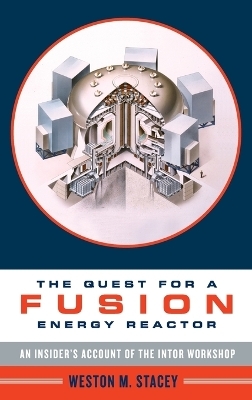
The Quest for a Fusion Energy Reactor
An Insider's Account of the INTOR Workshop
Seiten
2010
Oxford University Press Inc (Verlag)
978-0-19-973384-2 (ISBN)
Oxford University Press Inc (Verlag)
978-0-19-973384-2 (ISBN)
Based on the journal of one of the principal participants, this book provides a history of the IAEA INTOR Workshop (1978-88) during which hundreds of fusion scientists and engineers collaborated to define an experimental fusion energy reactor. The INTOR Workshop led to the present international ITER project, a collaborative effort to construct the first fusion energy reactor.
Concerns over the planet's limited energy sources are not new. For the past half-century, scientists from around the world have explored substitutes for fossil fuels. Among them, developed nations have invested considerable resources in the development of nuclear fusion technology. Thus, in 1978, scientists and engineers from Europe, Japan, the United States, and the former Soviet Union joined together under the banner of the INTOR Workshop (INternational group working on a TOkamak Reactor) to share their individual research on nuclear fusion's viability as an energy source. Their ten years of cooperative work on the design and development possibilities for harnessing nuclear energy planted the seeds for the International Thermonuclear Experimental Reactor (ITER), construction of which began in 2008 and whose goal it is to demonstrate the scientific and technical feasibility of fusion power.
Weston Stacey served as the INTOR Workshop's vice-chairman (and U.S. representative) and kept a journal in which he detailed both the scientific participants' technical work as well as their more political interactions. In this first person narrative, Stacey provides an accessible account (introducing explanatory material when necessary) of the research and development activities conducted to determine the viability of designing, constructing, and operating a tokamak experimental power reactor. Of more human interest were the obstacles the Workshop leaders and participants faced as they advanced their own countries' priorities while striving to make progress on the global future of nuclear fusion technology. Personal anecdotes illuminate the mixing of cultures and the challenges presented by the Cold War's unique political climate. While the focus of the book centers on the history of the INTOR Workshop, Stacey paints a full picture of the people and places involved in the work, how decisions were made, and how these efforts laid the groundwork for ITER's subsequent development. This text will appeal not only to those studying fusion science and engineering, but to anyone interested in a unique story of how international relations and scientific study intersect, ultimately one of collaboration for the sake of a common goal.
Concerns over the planet's limited energy sources are not new. For the past half-century, scientists from around the world have explored substitutes for fossil fuels. Among them, developed nations have invested considerable resources in the development of nuclear fusion technology. Thus, in 1978, scientists and engineers from Europe, Japan, the United States, and the former Soviet Union joined together under the banner of the INTOR Workshop (INternational group working on a TOkamak Reactor) to share their individual research on nuclear fusion's viability as an energy source. Their ten years of cooperative work on the design and development possibilities for harnessing nuclear energy planted the seeds for the International Thermonuclear Experimental Reactor (ITER), construction of which began in 2008 and whose goal it is to demonstrate the scientific and technical feasibility of fusion power.
Weston Stacey served as the INTOR Workshop's vice-chairman (and U.S. representative) and kept a journal in which he detailed both the scientific participants' technical work as well as their more political interactions. In this first person narrative, Stacey provides an accessible account (introducing explanatory material when necessary) of the research and development activities conducted to determine the viability of designing, constructing, and operating a tokamak experimental power reactor. Of more human interest were the obstacles the Workshop leaders and participants faced as they advanced their own countries' priorities while striving to make progress on the global future of nuclear fusion technology. Personal anecdotes illuminate the mixing of cultures and the challenges presented by the Cold War's unique political climate. While the focus of the book centers on the history of the INTOR Workshop, Stacey paints a full picture of the people and places involved in the work, how decisions were made, and how these efforts laid the groundwork for ITER's subsequent development. This text will appeal not only to those studying fusion science and engineering, but to anyone interested in a unique story of how international relations and scientific study intersect, ultimately one of collaboration for the sake of a common goal.
Weston Stacey is a plasma physicist and nuclear engineer with over 40 years of teaching and research experience in nuclear reactor and fusion research. He led the U.S. team in the IAEA INTOR Workshop that led to the ITER fusion energy reactor project, which is the subject of this book. He has published 9 textbooks or research monographs and more than 260 original research papers.
APPENDICES; GLOSSARY; BIBLIOGRAPHY
| Erscheint lt. Verlag | 27.5.2010 |
|---|---|
| Zusatzinfo | 8 line drawings & 10 halftones |
| Verlagsort | New York |
| Sprache | englisch |
| Maße | 208 x 145 mm |
| Gewicht | 411 g |
| Themenwelt | Naturwissenschaften ► Physik / Astronomie ► Atom- / Kern- / Molekularphysik |
| Naturwissenschaften ► Physik / Astronomie ► Hochenergiephysik / Teilchenphysik | |
| Technik ► Elektrotechnik / Energietechnik | |
| ISBN-10 | 0-19-973384-8 / 0199733848 |
| ISBN-13 | 978-0-19-973384-2 / 9780199733842 |
| Zustand | Neuware |
| Informationen gemäß Produktsicherheitsverordnung (GPSR) | |
| Haben Sie eine Frage zum Produkt? |
Mehr entdecken
aus dem Bereich
aus dem Bereich
Buch | Softcover (2024)
Wiley-VCH (Verlag)
59,90 €


